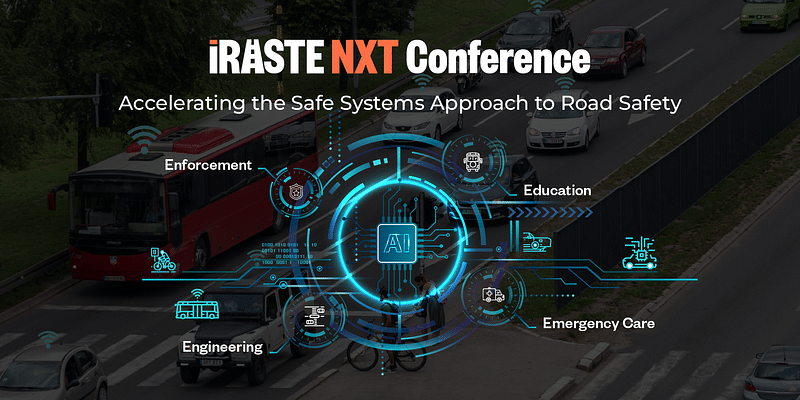
Key takeaways of iRASTE NXT Conference:
1. There are 18 deaths every hour in India due to road accidents. That leads to ~500,000 accidents every year.
2. From a GDP standpoint, road accident deaths and injuries cause a GDP loss of 3.14%.
3. Project iRASTE is on a mission to reduce road accidents through AI led multi-modal approach.
4. It has been deployed in Nagpur and Telangana and is being used to offer early warnings and alerts to drivers.
5. The project is working towards enabling accident-free Indian roads by 2030 through early detection and analytics.
6. Project iRASTE led to 31% reduction in accident rate for the lead operator (Hansa Travels) in ADAS equipped NMC buses.
Eighteen people die every hour in India due to road accidents. About 1,130 road accidents cause 432 deaths every day. Nitin Gadkari, Union Minister of road transport and highways, believes that this can be prevented with the use of technology.
At the iRASTE NXT Conference organised jointly by CSIR-CRRI, INAI@IIITH, and Intel, the minister said that artificial intelligence and allied technologies can be utilised to improve road safety. “We must use technology to mitigate the risks. This can be done by offering advanced alerts and road safety warnings to drivers,” he said.
The union minister emphasized that promoting safer roads is not just a social responsibility, but also an economic one.
“From an economic standpoint, road accidents cause a loss of 3.14% to the country’s GDP. This includes ~1.50 lakh deaths and ~3 lakh injuries every year. It is a serious problem that we need to solve,” said the union minister.
The conference is an initiative spearheaded by Project iRASTE (Intelligent Solutions for Road Safety through Technology and Engineering) that was launched in 2021 by a consortium consisting of IIIT Hyderabad, CSIR-Central Road Research Institute (CRRI), Intel, Mahindra & Mahindra, INAI & Nagpur Municipal Corporation (NMC).
Taking a special interest in technology-based mitigation strategies, the minister stated that Project iRASTE’s initial efforts have been fruitful due to the Advanced Driver Assistance System (ADAS). This system offers real-time safety alerts to drivers that help them avoid collisions. It is deployed across 450 buses of NMC & TSRTC in Telangana and is the largest such study in India. 7 out of 10 NMC drivers reported above average risk scores and the lead NMC operator, Hansa Travels, reported a 31% decline in accident rates in the study so far.
The next phase of the project is turning the insights into action and policy reforms across India. Talking about the efforts to make iRASTE a pan-India programme, Varma Konala, CEO, INAI said that the project’s focus so far has been on technical aspects and execution. INAI is an Applied AI research centre that helps build AI technologies to solve large-scale problems in the Indian context and is part of the consortium that runs Project iRASTE.
“In the next six months, our focus will be on engaging the regulatory and policy bodies so that this becomes something real,” he added.
Vision Zero Accidents
Making Project iRASTE a viable reality across the country is an immediate need. A look at the terrifying statistic makes the situation clear. India has the second-highest number of road accidents, with about 5 lakh accidents reported every year. In this, as union minister Nitin Gadkari pointed out, metro cities such as Delhi and Mumbai take the top spot.
He laid out a series of steps that need to be taken to bridge the gap.
1. Identifying the reasons for road accidents, including listing the black spots with the maximum fatalities.
2. Transformation in road engineering wherein public-private partnerships can improve the quality and condition of Indian roads.
3. Following traffic rules including lane discipline and speed limits.
The minister recommended a carrot-and-stick approach towards road discipline that will impose instant fines on violators and reward those who identify bad behaviour.
Project iRASTE’s goal is to use technology as a force multiplier to address road accidents. At the iRASTE NXT Conference, Dr. S. Velmurugan, Chief Scientist, CSIR-CRRI presented the key findings from Project iRASTE, Nagpur.
“Our mission is to bring down the number of crashes in India. The major concern that we are facing is that even if the number of crashes reduces, the death figures have stayed at ~150,000. We need to do a threadbare analysis to ascertain why some states are more prone to road accidents and related fatalities,” he added.
The data from Maharashtra shows highways as the biggest contributors to fatalities and the two most-affected groups are pedestrians and two-wheelers. Also, crashes at night contribute 60% to the total accidents. Velmurugan said it’s either engineering issues or drivers exceeding speed limits.
To deal with the issue, iRASTE Nagpur has brought about comprehensive design improvements as countermeasures. This included a Detailed Geometric Design Plan (GDP) that was delivered for the 38 locations identified as black spots and 33 locations tagged as grey spots. Black spots are places where accidents have already taken place and grey spots are locations that are at potential future black spots.
It is estimated that there can be a 60-66% reduction in overall road crashes coupled with a 40% reduction in fatalities on Nagpur’s city road network if all the countermeasures are implemented at the identified black spots.
Root causes and their solutions
Project iRASTE has a four-pronged approach towards road safety, which includes vehicle safety, mobility analysis, infrastructure safety, and training. Technology forms the backbone of the mission. Using ADAS and driver monitoring systems fitted into vehicles, the system sends out alerts whenever there is a risk of collision, abrupt lane changes, or speeding. This enables drivers to exercise caution and avoid road accidents.
At the conference, panellists discussed ways to turn vehicle and driver behaviour insights from Project iRASTE into policy recommendations. In addition, the stakeholders also deliberated on approaches to road safety for schools and leveraging technology to enhance road safety.
Addressing the conference, Prof. Manoranjan Parida, director, CSIR-CRRI, said that collaboration between enterprises, researchers, and government bodies is necessary to enable a gradual reduction in road accidents.
“Our project helps in the deployment of technology and engineering to solve road safety issues. We try to understand how people drive and what kind of corrective actions can be taken. In fact, we have identified grey spots through Project iRASTE in Nagpur, which require a series of interventions,” he added.
Jigesh Bhavsar, Road Safety Consultant, International Road Assessment Programme (iRAP) highlighted the iRAP star ratings being implemented to assess the risks of roads. Here, one-star roads have the highest risk and five-star roads have the lowest risks.
The way forward
Road accidents are nothing short of an emergency considering the deaths and injuries involved.
During the iRASTE NXT Conference, Kiran K Kapila, president (Emeritus), International Road Federation (IRF) Geneva, and founder president of IRF-India Chapter, said that global best practices can be utilised to curb the menace.
“About 13 lakh people die annually worldwide on roads, tantamount to 10 jumbo jets crashing every single day. We need to introspect whether we are doing enough,” he added.
IRF works towards promoting safer and sustainable roads globally. It has recommended under run protection devices be mandatorily fitted into existing and new vehicles on the front, side, and rear. These devices protect smaller vehicles from being lodged underneath a large commercial vehicle during collisions.
Making structural tweaks in the vehicles and automating responses to adverse risks were among the key themes discussed during the iRASTE NXT Conference.
During the session on leveraging technology to enhance the 4Es of road safety, the panellists deliberated on the need to identify emerging risks. Akhilesh Srivastava, Road Safety Ambassador, vice president, IRF-IC explained that AI can identify unknown risks effectively.
“Studies have shown that by alerting the driver two seconds prior to an accident, overall accidents can be reduced by 65%. I believe that ADAS must be made mandatory for all four-wheelers so that we can enable prevention. In addition, AI can be used to identify road quality and potholes so that a comprehensive road quality index is created,” he added.
Apart from holistic reforms, areas such as road safety for schools were also part of the conference’s agenda. During the school safety session, Juby Jose, Director, Intel said that ~85% of the accidents have a human error element in them. This means that these incidents are entirely preventable.
“Projects such as iRASTE seek collaboration. We must not work in silos, need cooperation between bureaucrats and technocrats, and must rely on indigenous technologies that are developed for Indian roads,” said Dr. Ekta Kapoor, Mission Director, National Mission on Interdisciplinary Cyber-Physical Systems.
Project iRASTE team also announced a Data Challenge to enable the wider AI developer community to develop models for additional insights based on the data collected in this study. INAI website has all the details.
While most of the sessions focused on the technologies related to 4Es (Engineering, Education, Enforcement, Emergency), Sameer Gautam from Traffic Rewards presented about their pilot project in Nagpur that adds a new element, Encouragement, to reward drivers that comply with traffic rules.
At the end of the day-long conference, the consensus was that AI and emerging technologies can bring about a transformational change in road safety.
Emphasising the importance of AI to improve road safety, the minister also called for the use of technology for regular inspections of bridges and tunnels.
“Cooperation, coordination and communication are required between all stakeholders. Together, we can make it happen,” he said.
With an ambitious target of a 50% reduction in deaths, injuries because of road accidents by 2030, technology is the only answer.


![Read more about the article [Funding roundup] O’2 Nails India, FlexC, Speedlabs raise early-stage deals](https://blog.digitalsevaa.com/wp-content/uploads/2022/05/Funding-1587044486257-300x150.png)


![Read more about the article [The Turning Point] Why Mukesh Bansal, Ankit Nagori chose to focus on health with Cult.fit](https://blog.digitalsevaa.com/wp-content/uploads/2021/06/Ankit-Nagori1-1623410114265-300x150.jpg)




